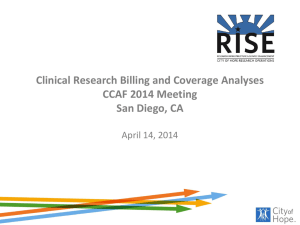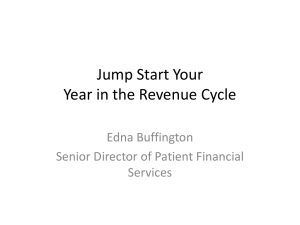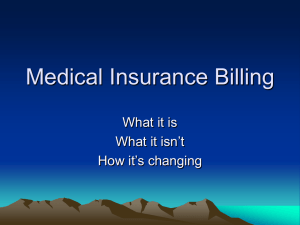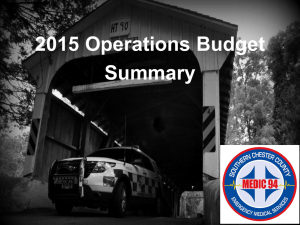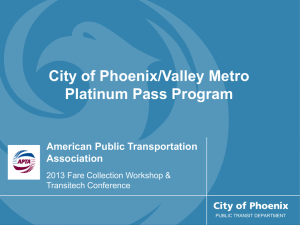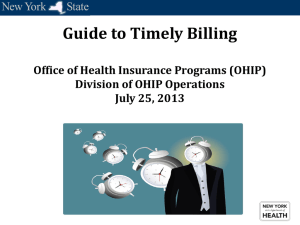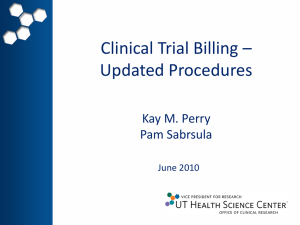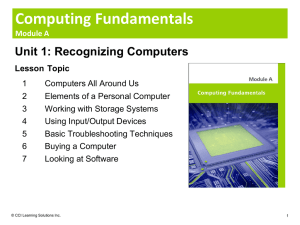Chapter 7 Visit Charges & Compliant Billing
advertisement
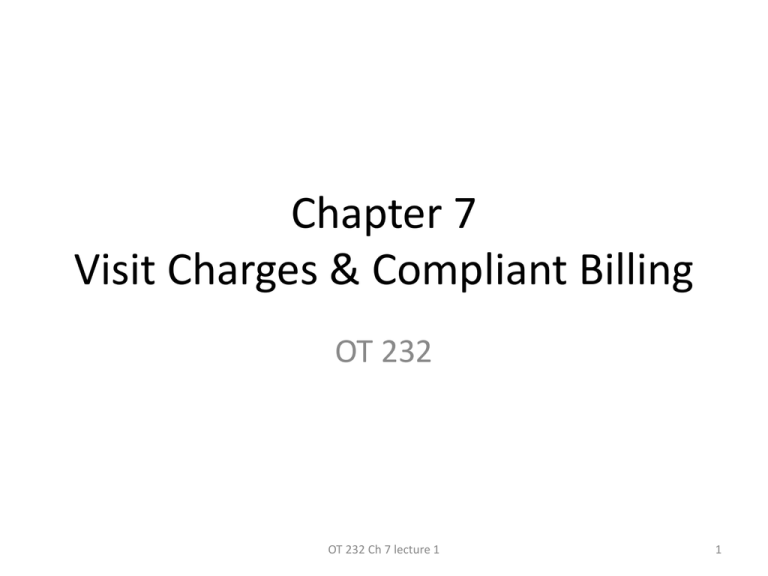
Chapter 7 Visit Charges & Compliant Billing OT 232 OT 232 Ch 7 lecture 1 1 Compliant Billing • C0mpliance? – Actions that satisfy official guidelines & requirements • Correct claims report the connection between a billed service & diagnosis – Code linkage • A clean claim will get the maximum amount of money in fast with no additional work • Consequences of non-compliance? – Box on 207 OT 232 Ch 7 lecture 1 2 Knowledge of Billing Rules • Must keep up-t0-date! – Insurance companies have bulletins, websites, etc. • Easier in a specialized office because less to track OT 232 Ch 7 lecture 1 3 Medicare Regulations: The Correct Coding Initiative • • • • CCI National policy on correct coding Come from CMS Controls improper coding that would lead to inappropriate payment • Updated quarterly • Has thousands of code combos called CCI edits that check claims via computers – Apply to claims that bill for more than one procedure for the same patient on the same day by same provider OT 232 Ch 7 lecture 1 4 CCI (cont’d.) • Also tests for unbundling – Incorrect billing practice of breaking a package of services into component parts & reporting them separately • Requires physicians to report only the more extensive version of the procedure performed OT 232 Ch 7 lecture 1 5 Organization of CCI edits • Column 1/Column 2 Code Pairs – Checks for unbundling – Col 1 includes all services described by Col 2 – Medicare pays for Col 1 – Software available to help check beforehand (Billing Tip, pg 211) – Ex pg 209 OT 232 Ch 7 lecture 1 6 Organization of CCI edits (cont’d.) • Mutually Exclusive Code Edits – MEC – Also uses 2 columns – Cannot be billed together – Medicare pays lower-paid – Ex pg 210 OT 232 Ch 7 lecture 1 7 Organization of CCI edits (cont’d.) • Modifier Indicators – Control modifier use to avoid CCI edits • Modifiers show particular circumstances related to a code on a claim – 1 – modifier may be used for special circumstance • Adjudicator will assess – 0 – no deal – 9 – original edit was a mistake; resubmit for payment if appropriate – Ex pg 211 OT 232 Ch 7 lecture 1 8 Medically Unlikely Edits • MUEs • Unit-of-service edits that check for clerical or software-based coding or billing errors • Established by CMS to reduce error rates • Initial set is based on anatomical considerations – Hysterectomy on a male • Will also reject billings in excess of Medicare allowances OT 232 Ch 7 lecture 1 9 Other Government Billing Regulations • The OIG Work Plan – Issued annually as part of Medicare Fraud and Abuse Initiative – Lists projects for sampling particular types of billing to determine whether there are problems. Practices then study these to make sure their procedures comply with regulations – OIG also issues advisory opinions • Legal advice to parties that ask specific questions – If the asking party follows the advice, they cannot be investigated on the matter – Good for others to read – OIG also summarizes findings after investigations & publishes the LEIE • List of Excluded Individuals/Entities – Have been found guilty of fraud and are now excluded from work with government programs OT 232 Ch 7 lecture 1 – Knowingly hiring excluded companies/people is illegal 10 Private Payer Regulations • • • • • CCI edits apply to Medicare claims only Private payers will develop their own edits May or may not share them Will have to call for clarification HIPAA Tip – pg 212 OT 232 Ch 7 lecture 2 11 Compliance Errors • Payers often base their decisions to pay or deny claims only on the diagnosis and procedure codes – Refers to ‘code linkage’ – The doctor must justify the procedure – Most payers will have edits to check for this – ‘Medical Necessity’ will vary by payer OT 232 Ch 7 lecture 2 12 Errors relating to Code Linkage & Medical Necessity • Codes that meet medical necessity generally meet these conditions – The CPT procedure codes match the ICD9 diagnosis codes – The procedures are not elective, experimental, or nonessential • Criteria varies by payer – The procedures are furnished at an appropriate level OT 232 Ch 7 lecture 2 13 Errors relating to the Coding Process • Truncated coding – SPECIFICITY!!! – Billing tip, pg 213 • Gender/age mismatch • Assumption coding, altering documentation after services are reported, coding w/out proper documentation • Reporting services provided by unlicensed or unqualified personnel • Not satisfying the conditions of coverage of a particular service OT 232 Ch 7 lecture 2 14 Errors related to the Billing Process • Billing noncovered services – If in doubt, look it up in the Schedule of Benefits • • • • • Unbundling Billing a consultation instead of an office visit Billing outdated codes ‘Upcoding’ or ‘downcoding’ Billing without signatures OT 232 Ch 7 lecture 2 15 Strategies for Compliance • Carefully define bundled codes and know global periods – Amount of time during which all services related to a surgical procedure are considered part of the package and not additionally reimbursed • Benchmark the Practice’s E/M codes with National Averages – Evaluation and management – Procedure codes that cover physicians’ services performed to determine the optimum course for patient care OT 232 Ch 7 lecture 2 16

